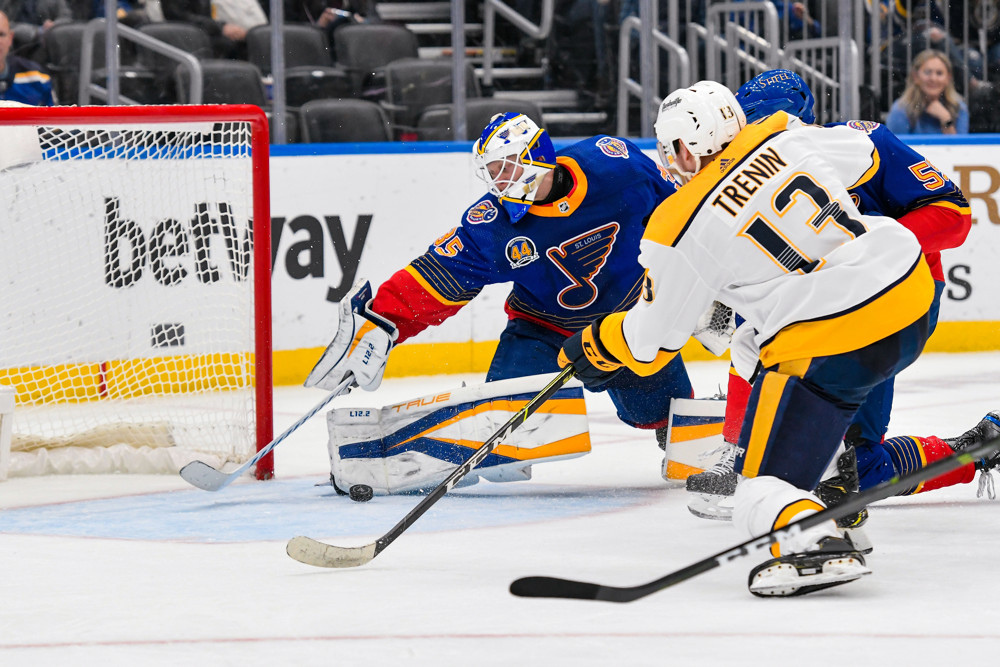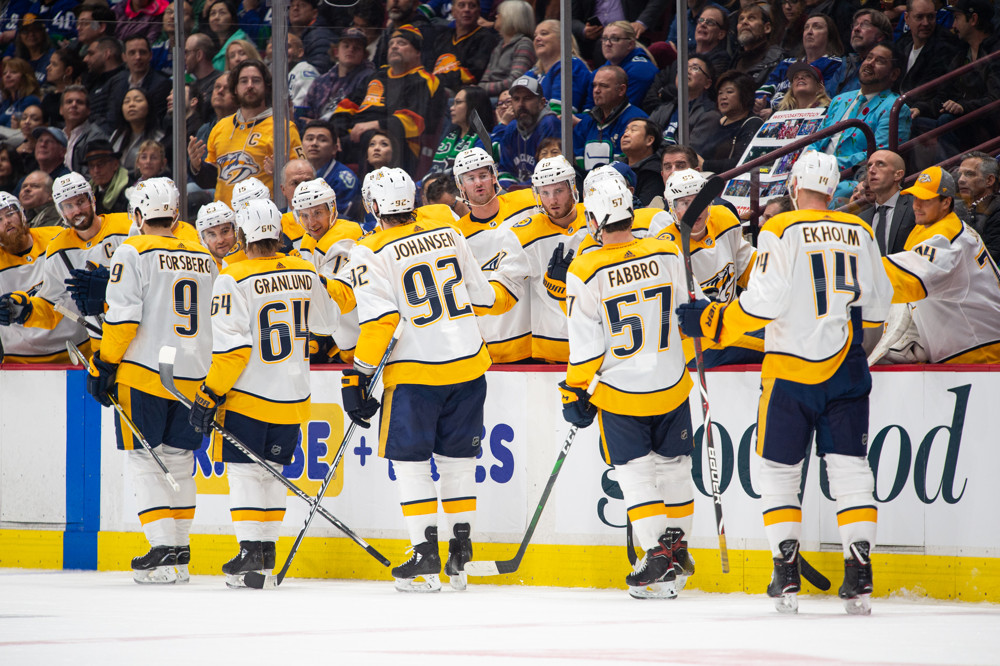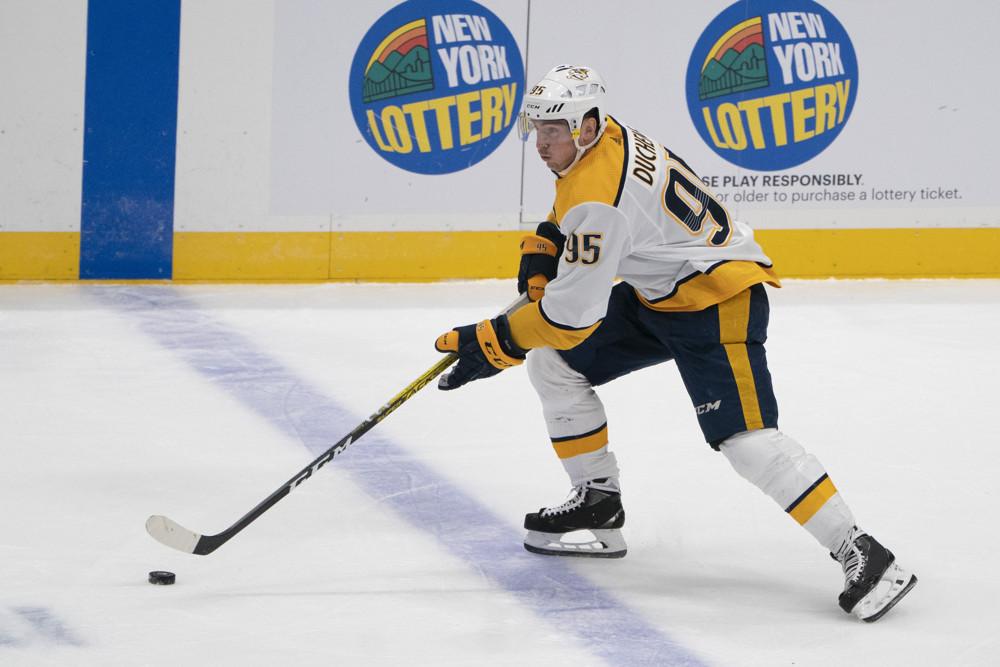Up to now in “Approachable Analytics,” we’ve covered shot attempts, zone starts, and scoring chances. Since we’ve put some of the groundwork behind us, we’ll transition into something that’s slightly more complex. The next metric, or really group of metrics, are commonly referred to as “per 60” stats.
These stats are used to determine who’s making the most of their ice time. Whether it’s shot attempts, points, scoring chances, or rebounds created, per 60 stats can be used to measure just about anything. The formula tells who is working most efficiently on the ice. More importantly, though, they serve as a way to standardize other metrics. Here’s an example:
In spite of any differences in ability, the truth is that Filip Forsberg will always produce more points than Colton Sissons at five on five. I can say this with certainty because Forsberg plays significantly more minutes than Sissons. Comparing their point production “apples to apples” is simply not informative. To make any educated decisions, we need to factor in their time on ice to any other metric we want to use.
The Formula
Like the other metrics we’ve discussed, calculating per 60 stats isn’t too complicated, although it might seem that way at first. To illustrate, I’ll use Filip Forsberg’s points per 60 last regular season. This equation tells us how many goals and assists Forsberg produced (at five-on-five) every 60 minutes. Here’s how it looks:
Okay so what are we looking at here? TP/60 simply means “total points per 60 minutes.” Points, of course, is just goals and assists combined. “TOI” refers to time on ice. So, in plain English, to find out how many goals and assists Filip Forsberg produced every sixty minutes, on average, divide his points by his ice time and multiply it all by 60. Remember, we’re only looking at five-on-five numbers here, no power plays, penalty kills, overtime, etc.
Let’s plug in some real numbers. Last regular season, Forsberg put up 37 points at five-on-five in just under 879 minutes of total ice time.
 So there you have it. For every 60 minutes with Forsberg on the ice, he produced 2.53 points. To complete the example, using the same approach, we find that Colton Sissons produced 1.06 points per 60 last season.
So there you have it. For every 60 minutes with Forsberg on the ice, he produced 2.53 points. To complete the example, using the same approach, we find that Colton Sissons produced 1.06 points per 60 last season.
What Per 60 Stats Tell Us
Each per 60 stat is not created equal. Shots per 60 is probably the best for predicting a player’s real contributions; the top scorers in the NHL consistently are near the top of that list. If you want to be a hipster and try to pick the next breakout star in the NHL, look for young players that produced a ton of shots per 60 last season.
A handful of analysts and pundits picked Viktor Arvidsson to be a potential star in 2016-17, based on his 56-game stint the previous year. Arvidsson had only tallied 16 points, but produced 11.86 shots per 60 while playing less than 12 minutes per night at five on five. Also to be considered was his very low shooting percentage (4.58%). In other words, Arvidsson was shooting the puck like a maniac, but those shots were finding the back of the net less often than expected. It didn’t take a genius to figure out that Arvidsson was a pretty safe bet as a future weapon.
As we’ve mentioned previously, George is a worshipper at the altar of high-danger scoring chances. He believes these chances are the key to winning games. The result is a near obsession with each player’s high-danger chances (HDC) produced per 60. Historically, at the highest ranks in this category have been players who hover around the front of the net (think James van Riemsdyk or Patric Hornqvist). Now, though, the NHL has evolved into game of speed. The result is folks like Connor McDavid, Brandon Saad, and Cam Atkinson flinding their way into the top 10. HDCs per 60 can often explain why a player is scoring more than his/her teammates, even if shooting less.
All that said, goals and primary assists per 60 are also valuable. Goals per 60 needs little explanation: how many goals are you scoring per sixty minutes, on average? Primary assists is slightly more cryptic. If you’ve watched hockey at all, you know that goals are often assisted by two players: (1) the player who passed to the goalscorer, and (2) the player who passed to the player who passed to the goalscorer. In this scenario, player 1 would be awarded a “primary assist,” and player 2 a “secondary assist.”
No doubt about it – assists are always good. However, while the secondary assist is certainly important, who deserves more praise? The guy who passes to the guy who shoots? Or the guy who passes to the guy who passes… ah, well, you get the point. Basically, measuring primary assists per 60 will tell you a lot more about who’s really contributing than total assists per 60.
How It Affects The Predators
 No matter how you cut it, the Predators were a weird team last season. Certain players excelled in one or two categories, but they rarely had anyone dominating overall. (Disclaimer: everything below only includes players with 500+ minutes of total time on ice last year).
No matter how you cut it, the Predators were a weird team last season. Certain players excelled in one or two categories, but they rarely had anyone dominating overall. (Disclaimer: everything below only includes players with 500+ minutes of total time on ice last year).
Viktor Arvidsson and Craig Smith produced massively in terms of shots per 60. In fact, they placed 4th and 8th in the entire NHL, respectively. In terms of high-danger chances per 60, Smith and Kevin Fiala were ranked 13th and 16th, respectively. These are great numbers for those players, but unfortunately the rest of the NHL’s top 100 for those metrics was heavily lacking Nashville representation. The only exceptions were Kevin Fiala (36th) for shots per 60 and Viktor Arvidsson (67th) for high danger chances.
As a sort of microcosm for the 2017-18 regular season, the Predators goal numbers look way better than their shot metrics and high danger chance numbers. There were five Predators in the top 100 for goals scored. The usual suspects were there (Smith, Fiala, Arvidsson), 44th was claimed by Scott Hartnell and 83rd by Calle Jarnkrok. Not bad for a defensive specialist, I’d say that should earn some power play time. Which begs the question, why wouldn’t he replace Colton Sissons on that unit? As usual, I digress.
Assists per 60 is where things really get interesting. Ryan Johansen is objectively the smartest passer on the squad, but didn’t crack the NHL’s top 100 in assists per 60. Craig Smith narrowly snuck in, and, impressively Filip Forsberg was actually in the league’s top-five. In terms of primary assists per 60, Filip Forsberg was actually the best in the NHL by a considerable margin.
What’s the point?
Per 60 stats are certainly valuable and informative, but not without limitations. Ice time is certainly an important context, but not the end-all be-all. For example, playing 10 minutes a night next to Ryan Johansen is objectively more helpful than playing 15 minutes next to, say, Nick Bonino.
The most important caveat when using per 60 stats is sample size. Players with extremely low time on ice (think AHLers who come up for a game or two), will have hugely inflated stats per 60. Really, it takes at least 20 games before these average stats start to be reliable. Still, though, they’re an important piece in the analytics puzzle. Slowly, it’s all starting to come together.
George and Michael are always open to questions, comments, and brief stints in the stockade. Feel free to reach out to them on Twitter (@GeorgeM1019 and @WadeM117), or to Penalty Box Radio on Twitter and Facebook.
















